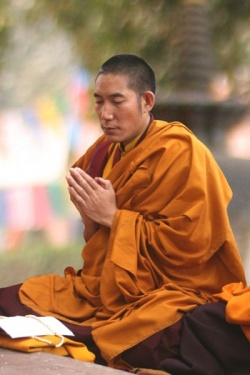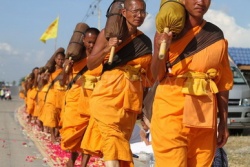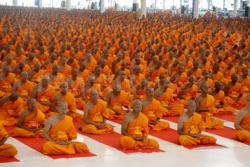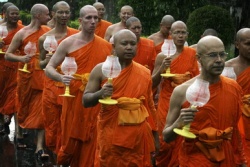Monks’ Ranks and Titles; Thailand
- See also :
- See also :
The special names and titles used for monks can be a very confusing matter.
Basically, monks may be referred to according to three “traditions” or tendencies: titles from the Buddhist canon; a developed system of ranks unique to the Thai sangha; and colloquial terms of reverence.
The use of these terms would depend on the context of the meeting. When referring to the length of time a monk has been in the order, a canonical reference may be used; in an urban, administrative setting, a formal rank/title might be applied;
while out in the village setting, local people would most likely use more colloquial references.
Upon ordination, a monk is given a new name, called a chaya.
This name usually comes from the Buddhist textual language, Pali.
Regardless of other factors listed below, a monk may continue to be known by the Thai generic term for a monk — phra — coupled with this new name.
The chaiya may be based on a part of the persons given name, such as initial consonants.
For example, in the case of this Swedish foreigner, the name Olson might go to the Pali name Obhaso — “the shining one.”
And so, one might be known as Phra Obhaso. (Strictly speaking, however, some people suggest that a monk should be called Samana or Bhikkhu, until he has attained a title, after which he would be known as Phra + title + name.
As with many things, actual practices are something different alltogether.)
Once a monk attains other titles, these names might be dropped in favor of the titles, as we will see...
Canonical Tradition of Ranks according to the Vinaya (all lists in descending order)
samanera (Thai, nen or samanen) — a novice monk who has yet to receive higher ordination
navaka — a newly ordained monk
nissaya-muttaka — a monk who has spent five years in the monkhood
majjhima — a monk who has spent between five to ten years in the Order (middle rank)
thera — a monk who has spent ten years or more in the monkhood and is eligible to be a preceptor (upajjhaya, one who ordains other monks)
maha-thera — often used to refer to a monk who has spent twenty years or more in the Order
In summary, monks are distinguished by the term navaka for those who have been in the Order five years or less, majjhima prior to the completion of ten years, thera after ten years.
Maha-thera is occasionally used for monks who have been in the Order twenty years or more. Among laity, the terms thera and maha-thera are heard most often.
The Developed Thai System of Ranks
After higher ordination:
maha — a monk who has passed Pali grade 3 (parian 3) [note:
in the past this term was often extended to laity who had been in the Buddhist order and had been “schooled” in Buddhist knowledge.
This term may also be used in a fond, somewhat facetious manner to refer to very reverential men who have spent time in the monkhood.]
Divisions of honorific titles/ranks:
II. phra racha khana (more colloquially known as a chao khun)
phra racha khana chan saman (“ordinary” class)
phra racha khana chan raj
phra racha khana chan thep
phra racha khana chan tham
phra racha khana chan rong somdet (“deputy” somdet, also known as chan phrom)
Monks with these titles would also have name ranks using the title as a kind of “prefix.”
For example, a monk with a raj title may have the name/rank of Phra Rajakawi; with a the ... Phra Thepkoson; and with tham may have the name of Phra Thammuni.
To make matters a bit more confusing and research more challenging, many of these names are romanized according to the monk’s preference, which can often include a mix of Sanskrit, Pali, or Thai.
For example, Phra Dhammapitaka romanizes his rank/name according to Pali instead of Thai (which would be Thammapitok).
III. somdet phra racha khana (full somdet rank)
There are about a handful of monks holding this rank. One of them will hold the highest title of Sangharaja, or Supreme Patriarch, of the Thai Buddhist Order.
Monks move through the ranks based on accomplishment and recognition of service.
Monks may be recornized for scholarly study, assistance to other high ranking monks, or becoming an administrator (especially an abbot) at a (royal) temple.
For example, A monk who is the abbot of a major royal temple, such as Wat Pho or Wat Mahathat would normally not have a rank below phra racha khana chan tha;
or if his rank were lower, upon appointment he would receive a higher rank.
At official functions, monks sit in order of rank.
All things being equal (rarely the case) the monk with the most tenure in the Order would sit ahead of another monk.
Some Examples of more Colloquial Thai Terms
luang phi — “Venerable Elder,” a reverential term for a younger, freshly ordained monk
luang ta — “Venerable Uncle,” a reverential term for an elderly monk without titles
luang pho — “Venerable Father,” a reverential term for an elderly monk
chao khun — a monk who holds phra racha khana rank (see above) but not used for the Sangharaja
A growing number of people feel that the bureaucracy of the monkhood is ineffective and that there is far too much emphasis placed on rank.
At any rate, it is clear the Thai penchant for hierarchy is mirrored in the system of ranks for monks.




